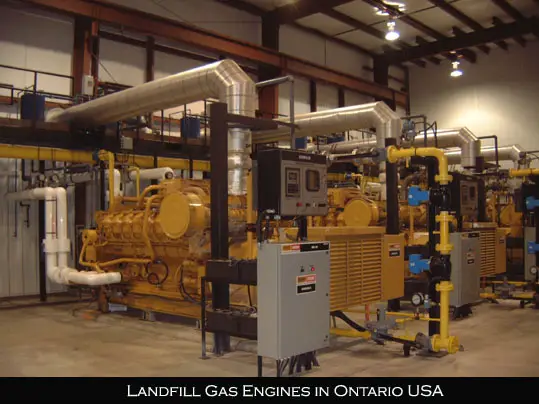There are five main ways to recover energy from landfill gas (LFG):
1. direct heating; 2. electricity generation; 3. chemical feedstock; 4. purification to pipeline-quality gas and; 5. heat recovery.
Recently, developed countries have been making increasing use of biogas generated from both waste water and municipal waste at landfill sites.
Municipal solid waste contains significant portions of organic materials that produce a variety of gaseous products when dumped, compacted, and covered in landfills. Anaerobic bacteria thrive in the oxygen-free environment, resulting in the decomposition of the organic materials and the production of primarily carbon dioxide and methane. Carbon dioxide is likely to leach out of the landfill because it is soluble in water. Methane, on the other hand, which is less soluble in water and lighter than air, is likely to migrate out of the landfill. Landfill gas energy facilities capture the methane (the principal component of natural gas) and combust it for energy.
The harvesting of biogas is an important role of waste management because methane is a greenhouse gas with a greater global warming potential than carbon dioxide. Landfill gas can be burned to produce electricity, usually with a reciprocating engine or micro-turbine. The gas is often used in a cogeneration arrangement, to generate electricity and use waste heat to warm the digesters or to heat buildings. Excess electricity can be sold to electricity suppliers. Electricity produced by anaerobic digesters is considered to be green energy and can attract subsidies.

Methods of Collection
The biogas can be collected by drilling wells into the waste and extracting it as it is formed. The landfill gas can then be used in an engine or turbine for power generation. Landfill sites can generate commercial quantities of landfill gas for up to 30 years after wastes have been deposited. Recovering this gas and using it as a fuel not only ensures the continued safety of the site after land filling has finished, but also provides a significant long term income from power sales.
The biological processes that take place in a landfill site can be harnessed in a specially designed vessel known as an anaerobic digester to accelerate the decomposition of wastes. Anaerobic digestion is the process in which volatile organic materials are broken down in the absence of oxygen. This biological process produces a gas, sometimes called biogas, principally composed of methane and carbon dioxide. The biogas can then be used as a fuel. The methane is generally burnt on site for heating or to produce electricity on a small scale.
Anecdotal evidence indicates that biogas was used for heating bath water in Assyria 3,000 years ago. The first digestion plant was said to have been built at a leper colony in Bombay, India in 1859. Anaerobic digestion is typically used on wet wastes, such as sewage sludge or animal slurries but the biodegradable fraction of municipal wastes can be added to wetter wastes to increase the biogas output. Digesters can be categorised by dry or wet systems – below 15 per cent dry solids is termed wet. Also digesters can operate within two temperature ranges, either at 350C (mesophilic) or 550C (thermophilic) Some digesters are loaded in batches while others have continuous feed.
Biomass gasification is the latest generation of biomass energy conversion processes, and is increasingly being used for waste disposal (although electricity from garbage was being used by the early 1900s). Today, systems are generally constructed at scales of around 50 MW. This scale of economy reduces investment costs of biomass electricity generation and most systems utilise gas turbine technology. High efficiencies (up to about 50%) are achievable using combined-cycle gas turbine systems, where waste heat from the gas turbine is recovered to produce steam for use in a steam turbine. Economic studies show that biomass gasification plants can be as economical as conventional coal-fired plants (Badin & Kirschner 1998). However, gas cleanup (removing corrosive products) to an acceptable standard for use in turbines remains the major challenge yet to be overcome.
Pyrolysis shares many of the characteristics of gasification. With gasification partial oxidation of the waste occurs, whilst with pyrolysis the objective is to heat the waste in the complete absence of oxygen. Gas, olefin liquid and char are produced in various quantities. The gas and oil can be processed, stored and transported, if necessary and combusted in an engine, gas turbine or boiler. Char can be recovered from the residue and used as a fuel, or the residue passed to a gasifier and the char gasified.
|
Biomass Technologies
Biomass Power What is Biofuel? Palm Oil Biodiesel Biodiesel from Algae Biodiesel from Tallow Ethanol Biofuel Biofuel Ethics Wood Gas Generator
|

